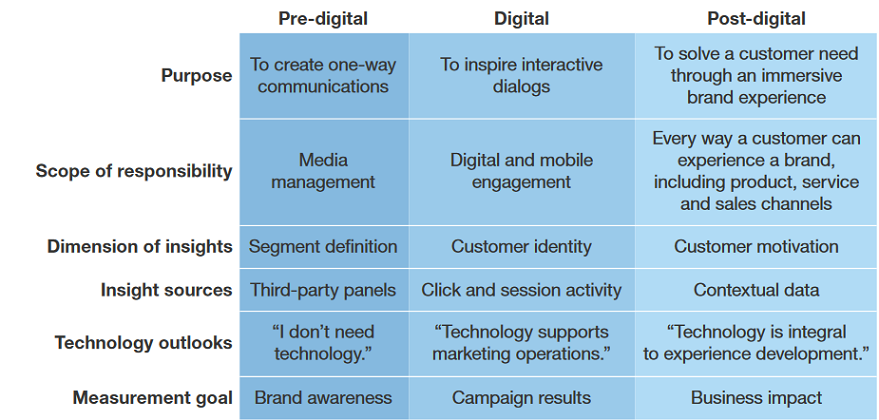By Michael Brenner

There’s a flaw in the world of digital marketing. We’re living in a post-digital world! Adopting new marketing technology, expanding digital assets and shifting those advertising dollars to social media advertising and PPC are all part of the digital approach. But the world we’re marketing within has already moved on. And the result? We’re missing the mark. 88 percent of consumers say all advertising has little or no impact on their purchasing decisions. This includes digital ads. Almost half of marketers aren’t even sure which digital methods work for them.
This spells a whole lot of in-the-dark-ages-marketing. While digital tools, marketing software, and data analysis are useful, these resources are part of the means to an end but are not the actual end solution. What is, however, the solution, is a mindset shift. What does the post-digital marketing mindset look like?
UNDERSTANDING THE POST-DIGITAL WORLD
Let’s take a look at the characteristics that are shaping the post-digital world – and dictating the only marketing approach that can survive in the future.
Customers are entitled.
In the post-digital era, customers don’t just want more. They are entitled to it. This means they won’t merely be disappointed when they encounter a brand that only offers a product or service. They probably won’t bother to make another purchase after the first encounter. There are too many brands out there that are willing to meet those entitled expectations.
– Frequent shopping rewards for B2C brands
– Loyalty discounts pricing for B2B
– Content that empowers or makes life more convenient, such as suggested items for B2C retailers to ‘finish the look’ or ‘complete the set’
– Online libraries, brand universities, and educational podcasts for B2B
Digital distinction has been dissolved.

There’s no more, this is digital, this isn’t. Everything from smart home appliances to tap and go payments is dissolving the boundaries between the digital and non-digital way of life.
– The British grocery chain, Tesco’s virtual grocery stores in Seoul’s subway stations, allows customers to grocery shop while waiting for the train with a smartphone app and QR codes
– Swedish communications company, Ericsson’s Maritime ICT brand is revolutionising freight shipping with smart sensors located on ships to monitor location, speed, and for heat-sensitive cargo, temperature, all in real-time
Digital insights fuel business strategy.
With the boundary between consumer and brand is getting thinner, or another way of looking at it, the bridge getting stronger, businesses are able to make better-informed decisions. This enables marketers to offer an even more sophisticated customer experience, which in turn is fuelling heightened customer expectations and entitlement.
– Royal Caribbean’s use of robotic bartenders to mix cocktails based on a customer’s previous order
– John Hancock Insurance’s use of fitness monitoring wearables to create personalised insurance premiums
Organisational culture is shifting to better meet customer needs.
All the push to create a more streamlined customer experience is also shifting organisational culture. Marketing, IT, customer service, sales. By becoming better aligned within the organisation, it is possible to offer customers even more.
– Pizza Hut’s CIO and CMO joining forces to create a push button mobile app
– Nissan’s use of buyer specifications to customise their products with sales informed factory automation
HOW THE TRADITIONAL AND DIGITAL MINDSET IS HOLDING YOUR MARKETING BACK
The post-digital world is forcing this mindset shift, whether marketers resist it or not. The more you are aware, however, of where your marketing approach is still stuck in the past, the more you can adjust your way of thinking to allow for a more effective post-digital approach today.

– Frequent exposure to a brand no longer etches your organisation into your customers’ minds. Instead, it annoys and creates a perception of being less trustworthy or authoritative.
– Generalised messaging to reach a larger audience now has the effect of turning away a larger number of people. Post-digital brands need to continually work towards greater personalisation, better segmenting, and getting to know your customers as individuals.
– There’s still too much emphasis on ads (83 percent of total marketing dollars is spent on online and offline advertising) even though we know it is contextually relevant interactions that work to convert, acquire and retain customers.
– Data isn’t as accurate as we like to think. An overemphasis on metrics and data analysis overlooks the human element, which is the key to the post-digital marketing mindset.
HOW TO MARKET TO HUMANS
Communicate, interact, and think like a human being. That’s the key to marketing in the post-digital era. It’s about using all the technology the digital era has brought us, not to turn marketing over to AI but to acquire the extra time and wisdom to engage with customers in a more meaningful way. Forrester’s Thriving in a Post-Digital World report calls for marketing professionals to be human, helpful and handy.

Offer an authentic brand personality by having clearly defined brand values and living up to them. Call up a client to check in. Send handwritten thank you notes. Respond directly to customer comments or questions on social media or via email. All of this builds trust and fosters long-term customer relationships.
Focus on creating solutions to customer problems and make understanding your buyers’ evolving pain points a priority. This way, not only are customers getting more value out of interacting with your brand, but your marketing itself will start transforming. The more you root your marketing decisions and strategies in customer solutions, versus trying to just communicate your message to the customers, the more you’ll start finding creative ways to build a multi-dimensional customer experience that will really wow your customers. It’s about setting the intention to customer-centric rather than brand-centric. Set the intention, and you’ll start moving in the right direction.
And finally, create space on your marketing team for a post-digital experience. This includes hiring people with different skills, being open to unconventional marketing ideas and continually learning. There’s a wealth of inspiration and knowledge out there to spark ideas and help you create more effective strategies. It’s all the brilliant campaigns that today’s post-digital brands – from startups to blue chip global companies – are already using.
By: Michael Brenner
Michael Brenner is a globally-recognised keynote speaker, author of The Content Formula and the CEO of Marketing Insider Group. He has worked in leadership positions in sales and marketing for global brands like SAP and Nielsen, as well as for thriving startups. Today, Michael shares his passion on leadership and marketing strategies that deliver customer value and business impact. He is recognised by the Huffington Post as a Top Business Keynote Speaker and a top CMO influencer by Forbes.
This article first featured in : https://marketinginsidergroup.com/content-marketing/marketers-can-thrive-post-digital-world/
